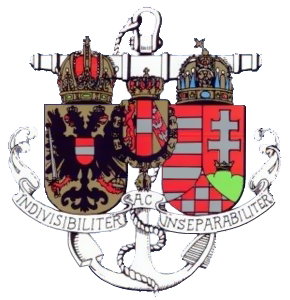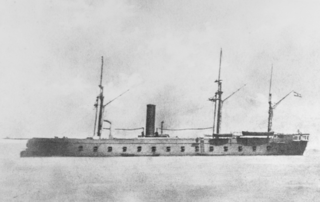The Austro-Hungarian Navy operated a pair of ironclad warships named SMS Kaiser Max:

The Austro-Hungarian Navy or Imperial and Royal War Navy was the naval force of Austria-Hungary. Ships of the k.u.k. Kriegsmarine were designated SMS, for Seiner Majestät Schiff. Existing between 1867 and 1918, the k.u.k. Kriegsmarine came into being after the formation of Austria-Hungary in 1867, and ceased to exist upon the Empire's defeat and subsequent collapse at the end of World War I.

An ironclad is a steam-propelled warship protected by iron or steel armor plates used in the early part of the second half of the 19th century. The ironclad was developed as a result of the vulnerability of wooden warships to explosive or incendiary shells. The first ironclad battleship, Gloire, was launched by the French Navy in November 1859. The British Admiralty had been considering armored warships since 1856 and prepared a draft design for an armored corvette in 1857; in early 1859 the Royal Navy started building two iron-hulled armored frigates, and by 1861 had made the decision to move to an all-armored battle fleet. After the first clashes of ironclads took place in 1862 during the American Civil War, it became clear that the ironclad had replaced the unarmored ship of the line as the most powerful warship afloat. This type of ship would come to be very successful in the American Civil War.
- SMS Kaiser Max (1862), an armored frigate launched in 1862
- SMS Kaiser Max (1875), a center battery ship launched in 1875

SMS Kaiser Max was the lead ship of the Kaiser Max class of armored frigates built for the Austrian Navy in the 1860s. Her keel was laid in October 1861 at the Stabilimento Tecnico Triestino shipyard; she was launched in March 1862, and was completed in 1863. She carried her main battery—composed of sixteen 48-pounder guns and fifteen 24-pounders—in a traditional broadside arrangement, protected by an armored belt that was 110 mm (4.3 in) thick.

SMS Kaiser Max was an ironclad warship built for the Austro-Hungarian Navy in the 1870s, the lead ship of the Kaiser Max class. The ship was purportedly the same vessel that had been laid down in 1861, and had simply been reconstructed. This was a fiction, however; the head of the Austro-Hungarian Navy could not secure funding for new ships, but reconstruction projects were uncontroversial, so he "rebuilt" the three earlier Kaiser Max-class ironclads. Only the engines and parts of the armor plate were reused in the new Kaiser Max, which was laid down in February 1874, launched in December 1875, and commissioned in October 1876. The ship's career was fairly limited, in part due to slender naval budgets that prevented much active use. She made foreign visits and took part in limited training exercises in the 1880s and 1890s. Long since obsolete, Kaiser Max was removed from service in 1904 and converted into a barracks ship. After World War I, the ship was transferred to the Royal Yugoslav Navy as a war prize and renamed Tivat. Her fate thereafter is uncertain, either being sold for scrap in 1924 or retained through 1941.
| This article includes a list of ships with the same or similar names. If an internal link for a specific ship led you here, you may wish to change the link to point directly to the intended ship article, if one exists. |








